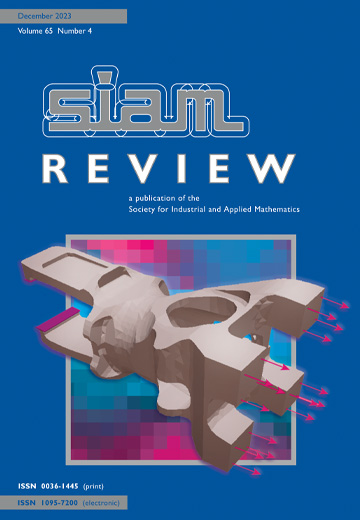NeuralUQ: A Comprehensive Library for Uncertainty Quantification in Neural Differential Equations and Operators
IF 6.1
1区 数学
Q1 MATHEMATICS, APPLIED
引用次数: 0
Abstract
SIAM Review, Volume 66, Issue 1, Page 161-190, February 2024.Uncertainty quantification (UQ) in machine learning is currently drawing increasing research interest, driven by the rapid deployment of deep neural networks across different fields, such as computer vision and natural language processing, and by the need for reliable tools in risk-sensitive applications. Recently, various machine learning models have also been developed to tackle problems in the field of scientific computing with applications to computational science and engineering (CSE). Physics-informed neural networks and deep operator networks are two such models for solving partial differential equations (PDEs) and learning operator mappings, respectively. In this regard, a comprehensive study of UQ methods tailored specifically for scientific machine learning (SciML) models has been provided in [A. F. Psaros et al., J. Comput. Phys., 477 (2023), art. 111902]. Nevertheless, and despite their theoretical merit, implementations of these methods are not straightforward, especially in large-scale CSE applications, hindering their broad adoption in both research and industry settings. In this paper, we present an open-source Python library (ŭlhttps://github.com/Crunch-UQ4MI), termed NeuralUQ and accompanied by an educational tutorial, for employing UQ methods for SciML in a convenient and structured manner. The library, designed for both educational and research purposes, supports multiple modern UQ methods and SciML models. It is based on a succinct workflow and facilitates flexible employment and easy extensions by the users. We first present a tutorial of NeuralUQ and subsequently demonstrate its applicability and efficiency in four diverse examples, involving dynamical systems and high-dimensional parametric and time-dependent PDEs.
NeuralUQ:神经微分方程和算子不确定性量化综合库
SIAM 评论》,第 66 卷第 1 期,第 161-190 页,2024 年 2 月。 由于深度神经网络在计算机视觉和自然语言处理等不同领域的快速应用,以及风险敏感应用对可靠工具的需求,机器学习中的不确定性量化(UQ)目前正引起越来越多的研究兴趣。最近,人们还开发了各种机器学习模型,以解决科学计算领域的问题,并将其应用于计算科学与工程(CSE)。物理信息神经网络和深度算子网络就是这样两种模型,它们分别用于求解偏微分方程(PDE)和学习算子映射。在这方面,[A. F. Psaros 等,J. Comput. Phys.,477 (2023),art. 111902]对专门为科学机器学习(SciML)模型定制的 UQ 方法进行了全面研究。然而,尽管这些方法具有理论上的优点,但其实现并不简单,尤其是在大规模 CSE 应用中,这阻碍了它们在研究和工业环境中的广泛应用。在本文中,我们介绍了一个开源 Python 库 (ŭlhttps://github.com/Crunch-UQ4MI),称为 NeuralUQ,并附有教学教程,用于以方便和结构化的方式在 SciML 中使用 UQ 方法。该库设计用于教育和研究目的,支持多种现代 UQ 方法和 SciML 模型。它基于简洁的工作流程,便于用户灵活使用和轻松扩展。我们首先介绍了 NeuralUQ 的教程,随后在四个不同的示例中演示了它的适用性和效率,这些示例涉及动力系统和高维参数与时间相关的 PDE。
本文章由计算机程序翻译,如有差异,请以英文原文为准。
求助全文
约1分钟内获得全文
求助全文
来源期刊

SIAM Review
数学-应用数学
CiteScore
16.90
自引率
0.00%
发文量
50
期刊介绍:
Survey and Review feature papers that provide an integrative and current viewpoint on important topics in applied or computational mathematics and scientific computing. These papers aim to offer a comprehensive perspective on the subject matter.
Research Spotlights publish concise research papers in applied and computational mathematics that are of interest to a wide range of readers in SIAM Review. The papers in this section present innovative ideas that are clearly explained and motivated. They stand out from regular publications in specific SIAM journals due to their accessibility and potential for widespread and long-lasting influence.
 求助内容:
求助内容: 应助结果提醒方式:
应助结果提醒方式:


